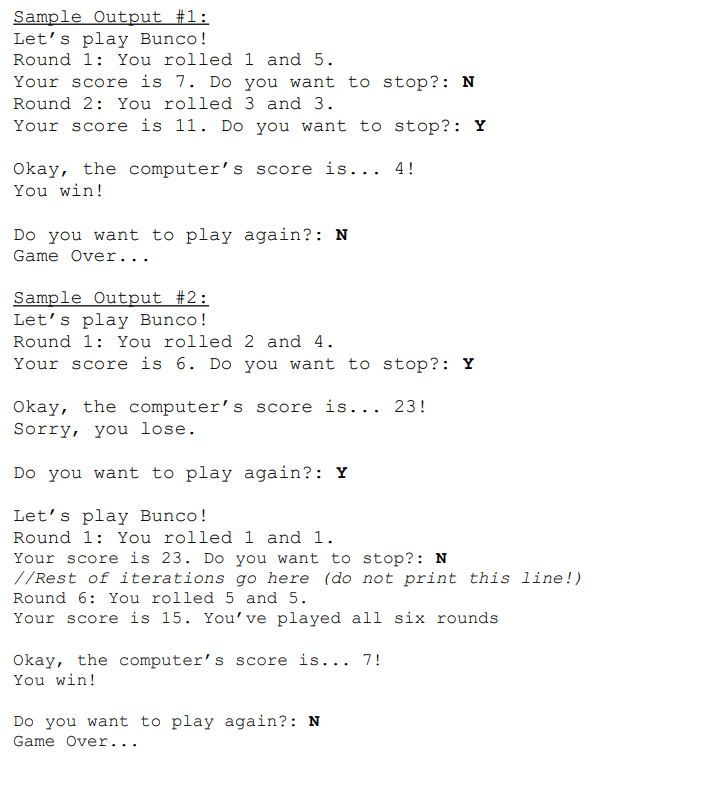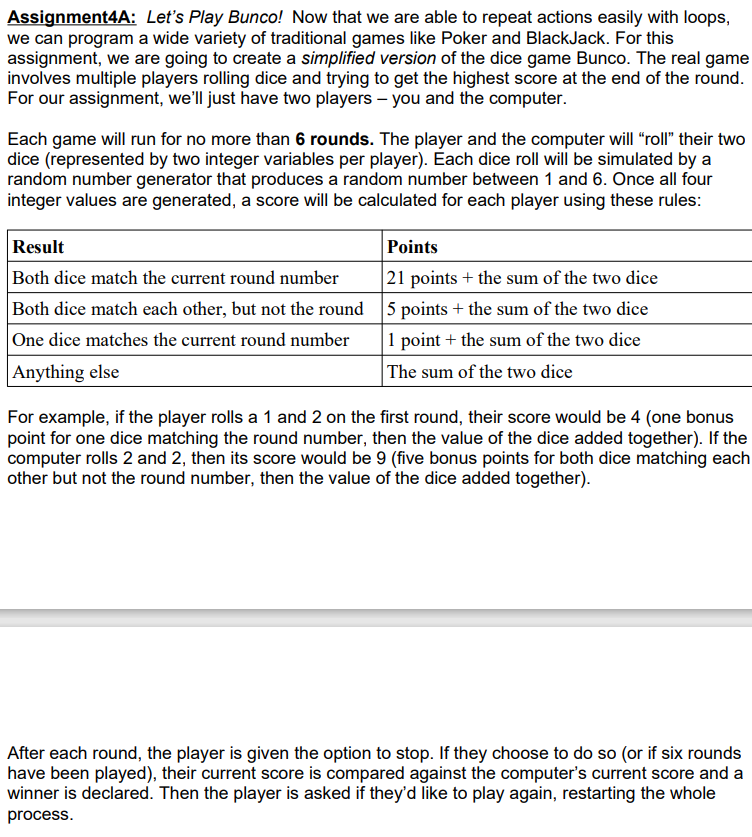Assignment4A: Let's Play Bunco! Now that we are able to repeat actions easily with loops, we can program a wide variety of traditional games like Poker and BlackJack. For this assignment, we are going to create a simplified version of the dice game Bunco. The real game involves multiple players rolling dice and trying to get the highest score at the end of the round. For our assignment, we'll just have two players – you and the computer. Each game will run for no more than 6 rounds. The player and the computer will "roll" their two dice (represented by two integer variables per player). Éach dice roll will be simulated by a random number generator that produces a random number between 1 and 6. Once all four integer values are generated, a score will be calculated for each player using these rules: Result Points Both dice match the current round number 21 points + the sum of the two dice Both dice match each other, but not the round 5 points + the sum of the two dice |1 point + the sum of the two dice The sum of the two dice One dice matches the current round number Anything else For example, if the player rolls a 1 and 2 on the first round, their score would be 4 (one bonus point for one dice matching the round number, then the value of the dice added together). If the computer rolls 2 and 2, then its score would be 9 (five bonus points for both dice matching each other but not the round number, then the value of the dice added together). After each round, the player is given the option to stop. If they choose to do so (or if six rounds have been played), their current score is compared against the computer's current score and a winner is declared. Then the player is asked if they'd like to play again, restarting the whole process.
Assignment4A: Let's Play Bunco! Now that we are able to repeat actions easily with loops, we can program a wide variety of traditional games like Poker and BlackJack. For this assignment, we are going to create a simplified version of the dice game Bunco. The real game involves multiple players rolling dice and trying to get the highest score at the end of the round. For our assignment, we'll just have two players – you and the computer. Each game will run for no more than 6 rounds. The player and the computer will "roll" their two dice (represented by two integer variables per player). Éach dice roll will be simulated by a random number generator that produces a random number between 1 and 6. Once all four integer values are generated, a score will be calculated for each player using these rules: Result Points Both dice match the current round number 21 points + the sum of the two dice Both dice match each other, but not the round 5 points + the sum of the two dice |1 point + the sum of the two dice The sum of the two dice One dice matches the current round number Anything else For example, if the player rolls a 1 and 2 on the first round, their score would be 4 (one bonus point for one dice matching the round number, then the value of the dice added together). If the computer rolls 2 and 2, then its score would be 9 (five bonus points for both dice matching each other but not the round number, then the value of the dice added together). After each round, the player is given the option to stop. If they choose to do so (or if six rounds have been played), their current score is compared against the computer's current score and a winner is declared. Then the player is asked if they'd like to play again, restarting the whole process.
C++ Programming: From Problem Analysis to Program Design
8th Edition
ISBN:9781337102087
Author:D. S. Malik
Publisher:D. S. Malik
Chapter4: Control Structures I (selection)
Section: Chapter Questions
Problem 17PE: Samantha and Vikas are looking to by a house in a new development. After looking at various modelsm...
Related questions
Question
coding language c++

Transcribed Image Text:Sample Output #1:
Let's play Bunco!
Round 1: You rolled 1 and 5.
Your score is 7. Do you want to stop?: N
Round 2: You rolled 3 and 3.
Your score is 11. Do you want to stop?: Y
Okay, the computer's score is... 4!
You win!
Do you want to play again?: N
Game Over...
Sample Output #2:
Let's play Bunco!
Round 1: You rolled 2 and 4.
Your score is 6. Do you want to stop?: Y
Okay, the computer's score is... 23!
Sorry, you lose.
Do you want to play again?: Y
Let's play Bunco!
Round 1: You rolled 1 and 1.
Your score is 23. Do you want to stop?: N
//Rest of iterations go here (do not print this line!)
Round 6: You rolled 5 and 5.
Your score is 15. You’ve played all six rounds
Okay, the computer's score is... 7!
You win!
Do you want to play again?: N
Game Over...

Transcribed Image Text:Assignment4A: Let's Play Bunco! Now that we are able to repeat actions easily with loops,
we can program a wide variety of traditional games like Poker and BlackJack. For this
assignment, we are going to create a simplified version of the dice game Bunco. The real game
involves multiple players rolling dice and trying to get the highest score at the end of the round.
For our assignment, we'll just have two players – you and the computer.
Each game will run for no more than 6 rounds. The player and the computer will "roll" their two
dice (represented by two integer variables per player). Éach dice roll will be simulated by a
random number generator that produces a random number between 1 and 6. Once all four
integer values are generated, a score will be calculated for each player using these rules:
Result
Points
|21 points + the sum of the two dice
Both dice match the current round number
Both dice match each other, but not the round 5 points + the sum of the two dice
One dice matches the current round number
1 point + the sum of the two dice
The sum of the two dice
Anything else
For example, if the player rolls a 1 and 2 on the first round, their score would be 4 (one bonus
point for one dice matching the round number, then the value of the dice added together). If the
computer rolls 2 and 2, then its score would be 9 (five bonus points for both dice matching each
other but not the round number, then the value of the dice added together).
After each round, the player is given the option to stop. If they choose to do so (or if six rounds
have been played), their current score is compared against the computer's current score and a
winner is declared. Then the player is asked if they'd like to play again, restarting the whole
process.
Expert Solution
This question has been solved!
Explore an expertly crafted, step-by-step solution for a thorough understanding of key concepts.
This is a popular solution!
Trending now
This is a popular solution!
Step by step
Solved in 3 steps with 3 images

Recommended textbooks for you

C++ Programming: From Problem Analysis to Program…
Computer Science
ISBN:
9781337102087
Author:
D. S. Malik
Publisher:
Cengage Learning

C++ Programming: From Problem Analysis to Program…
Computer Science
ISBN:
9781337102087
Author:
D. S. Malik
Publisher:
Cengage Learning